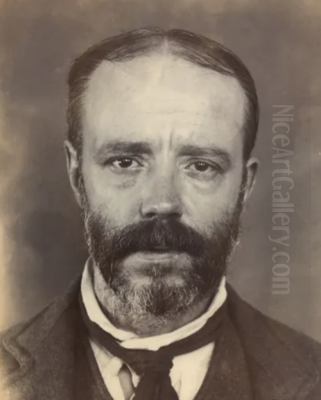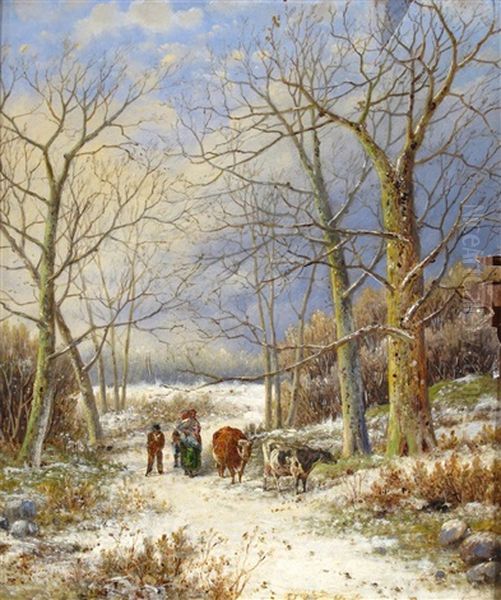
Hendrik Barend Koekkoek stands as a pivotal figure in the rich tapestry of 19th-century Dutch art. Born in Middelburg in 1803 and passing away in 1862, his life spanned a period of significant artistic evolution in the Netherlands. He emerged not only as a master painter in his own right but also as the scion of a remarkable artistic dynasty, the Koekkoek family, renowned for their contributions to landscape and marine painting. Celebrated during his lifetime and revered posthumously, Koekkoek earned the moniker "Prince of Landscape Painters," a testament to his exceptional skill and the profound impact he had on the Dutch Romantic movement. His work is characterized by meticulous detail, atmospheric depth, and a deep reverence for the natural world, securing his place as one of the most important landscape artists of his era.
Early Life and Artistic Formation
Hendrik Barend Koekkoek's journey into the world of art began under the direct tutelage of his father, Johannes Hermanus Koekkoek, himself a respected marine painter. This familial immersion provided a foundational understanding of technique and composition. Seeking to further hone his skills, Koekkoek enrolled at the prestigious Royal Academy of Fine Arts in Amsterdam. There, he absorbed the academic traditions while beginning to forge his own artistic identity. His education was further enriched by the influence of established masters, including the landscape painter Abraham [Teerlink or Van Strij, name incomplete in source], whose guidance likely helped shape Koekkoek's approach to depicting nature. This combination of familial instruction and formal academic training laid the groundwork for his future success, blending technical proficiency with an emerging personal vision.
The Essence of Dutch Romanticism

Koekkoek became a leading exponent of Dutch Romanticism, an artistic movement that flourished from the mid-19th century until around 1870. This style emphasized the sublime beauty and power of nature, often imbued with a sense of nostalgia and idealized harmony. Koekkoek's paintings perfectly encapsulate these ideals. His preferred subjects were idyllic landscapes, often featuring majestic trees, dense forests, winding rivers, rolling hills, and occasionally picturesque ruins nestled within the scenery. He possessed an extraordinary ability to capture the nuances of light and atmosphere, rendering the golden glow of sunrise or sunset with remarkable sensitivity. His compositions frequently include small human or animal figures, dwarfed by the grandeur of their surroundings, serving to heighten the sense of nature's magnificence and humanity's place within it.
Influences and Artistic Dialogue
While firmly rooted in the Romantic tradition, Koekkoek's art also reveals a deep engagement with the legacy of the Dutch Golden Age of painting. He drew significant inspiration from 17th-century masters such as Meindert Hobbema and Jacob van Ruisdael, particularly admiring their detailed rendering of foliage and their ability to convey the specific character of the Dutch landscape. Echoes of Jan van Goyen's atmospheric perspective can also be discerned in his work. Furthermore, Koekkoek integrated influences from Italianate painters, known for their warm light and idealized pastoral scenes. This synthesis of native Dutch tradition and broader European influences allowed him to create landscapes that were both specific in their detail and universal in their emotional appeal, resonating with a desire for stability and harmony prevalent in his time.
Signature Style and Technique
The hallmark of Hendrik Barend Koekkoek's style is his meticulous attention to detail combined with a masterful control over light and shadow. He rendered trees, leaves, and bark with almost botanical precision, yet never sacrificed the overall atmospheric unity of the scene. His brushwork, while fine, remained expressive, imbuing his landscapes with a sense of vitality. The interplay of light filtering through leaves, reflecting off water, or illuminating distant hills was a key element of his compositions, creating depth and drama. He skillfully employed perspective and compositional structure to lead the viewer's eye into the scene, often creating vistas that felt both expansive and intimate. This technical virtuosity served his romantic vision, transforming ordinary natural scenes into poetic statements.
Masterworks and Representative Pieces
Several works stand out as exemplars of Koekkoek's artistic achievement. His painting titled Standing Farmer with a Rake and a Jug over his shoulder showcases his ability to integrate figures naturally into a landscape setting, capturing a moment of rural life with sensitivity and detail. The play of light on the foliage and the careful rendering of the farmer's posture demonstrate his observational skills. Another significant work, A Winter Landscape, reveals his versatility in capturing different seasons and moods. Such scenes often highlight his skill in depicting the subtle colours and textures of snow, the bare branches of trees against a winter sky, and the specific quality of light during colder months. The painting El Aston Valley (likely a reference to a view in the Ardennes or a similar location, dated 1847 in the source material) is cited as a prime example of his high technical skill in handling complex compositions and nuanced light effects, further cementing his reputation for excellence.
The Koekkoek Artistic Dynasty
Hendrik Barend Koekkoek was not an isolated talent but the most celebrated member of an extensive family of artists. His father, Johannes Hermanus Koekkoek, specialized in marine subjects, establishing the family's artistic reputation. Hendrik Barend's brothers also pursued artistic careers; Barend Cornelis Koekkoek became a highly renowned landscape painter himself (though the source text confusingly attributes B.C.'s dates and achievements to Hendrik Barend), while Hermanus Koekkoek followed more closely in his father's footsteps as a marine painter. Another family member mentioned as active is Willem Koekkoek, who also contributed to the landscape genre. This strong familial connection to the arts created a supportive, albeit potentially competitive, environment that undoubtedly fostered artistic development across generations. The Koekkoek name became synonymous with high-quality landscape and marine painting in the 19th century.
Teaching and Mentorship: The Cleves Academy
Beyond his own prolific output, Hendrik Barend Koekkoek made significant contributions as an educator. In 1841, recognizing the need for structured artistic training outside the major academies, he founded his own drawing academy in Cleves (Kleve), Germany, where he had settled. This institution attracted numerous aspiring artists eager to learn from the master. Among his notable pupils were Johann Klomberg and Willem Fredrik Krusenmarin (likely Willem Frederik Kruseman), who went on to establish their own careers, carrying forward aspects of Koekkoek's style and approach. By establishing the Cleves Academy, Koekkoek not only disseminated his technical knowledge but also played a crucial role in shaping the next generation of Romantic painters, extending his influence beyond his own canvases.
Contemporaries: Collaboration and Competition
The 19th-century Dutch art scene was vibrant, and Koekkoek interacted with many contemporaries. Within his own family, there was inherent collaboration through shared learning and artistic lineage, but also potential competition, particularly with his brother Willem Koekkoek, who also painted landscapes. Outside the family, Andreas Schelfhout was another highly regarded landscape painter of the era. While Schelfhout's work sometimes shows Koekkoek's influence, they maintained distinct styles and likely competed for patronage and recognition in the art market. Koekkoek's engagement with movements like the Laren School and the Hague School, mentioned as influences in the source material, suggests an awareness of and dialogue with broader artistic trends evolving during his later career, even as he remained committed to his Romantic ideals.
Recognition and International Acclaim
Hendrik Barend Koekkoek achieved remarkable success during his lifetime, earning widespread acclaim both domestically and internationally. His reputation extended far beyond the Netherlands, with his works sought after by collectors and institutions across Europe. He enjoyed prestigious patronage, counting King Frederick William IV of Prussia and Tsar Alexander II of Russia among his admirers and clients. His participation in the influential Paris Salons brought further accolades; he was awarded gold medals on three separate occasions, a significant honour reflecting his standing in the European art world. In recognition of his artistic contributions, he was decorated as a Knight of the Legion of Honour in France and received the Order of Leopold in Belgium. This level of recognition solidified his status as the preeminent Dutch landscape painter of his generation.
Legacy and Historical Evaluation
Hendrik Barend Koekkoek's legacy endures through his breathtaking landscapes and his influence on Dutch Romanticism. His title, "Prince of Landscape Painters," reflects the high esteem in which he was held by his contemporaries and subsequent generations. His works are prized possessions in major museum collections worldwide, including the Rijksmuseum in Amsterdam and the Metropolitan Museum of Art in New York, ensuring their accessibility to the public. Art historians regard him as a key figure who successfully blended the meticulous observation of the Dutch Golden Age tradition with the emotional depth and idealized vision of Romanticism. His paintings not only capture the beauty of nature but also reflect the 19th-century yearning for harmony, stability, and the picturesque.
Enduring Influence
The art of Hendrik Barend Koekkoek continues to captivate viewers with its technical brilliance and poetic sensibility. He set a standard for landscape painting in the Netherlands during the Romantic era, influencing countless artists through his work and his teaching. His ability to evoke mood and atmosphere, combined with his unwavering attention to detail, created landscapes that feel both real and idealized, inviting contemplation and admiration. As the leading figure of the Koekkoek dynasty and a master of Dutch Romanticism, Hendrik Barend Koekkoek's contribution to art history remains significant, his paintings serving as timeless celebrations of the natural world.